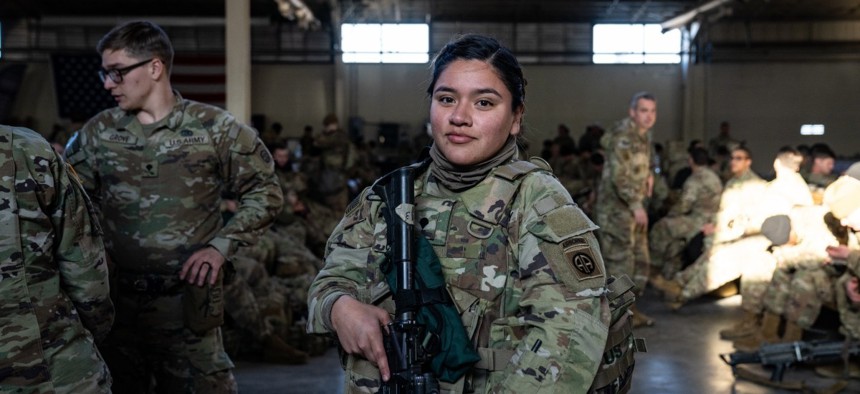
A U.S. Army Paratrooper assigned to the 82nd Airborne Division prepares to depart Pope Army Airfield, N.C. Feb. 14, 2022. U.S. Army photo Sgt. Hunter Garcia
In About-Face, Army Expects to Shrink Next Year
Chief of Staff McConville says recruiters need to reach families whose children have not served.
Last year, Army Chief of Staff Gen. James McConville said he’d like to add 70,000 soldiers to end strength. This year, he’s advocating “quality” over “quantity” and preparing to shrink the service by 12,000 troops, to 473,000. What happened?
Recruiting got harder, McConville said at a Defense Writers Group event on Thursday.
“We took a small reduction in end strength,” he said. “I would just tell you right now that recruiting to the military is challenging work in the war for talent.”
With unemployment low and inflation high, the Biden administration is proposing to give current service members a record pay raise while keeping the Army’s budget about the same.
To win more recruits, McConville said, his service needs to spread the Army word beyond the relatively small number of families whose young men and women have signed up in the past.
“Some people will talk about the Army and the military becoming a family business. A military family business. And I'm not so sure that's best for the nation,” he said.
The vast majority—79 percent—of new recruits have a family member who served in the military. While only 10 percent of high schools in the U.S. have Junior Reserve Officers’ Training Corps (JROTC) programs, 49 percent of new recruits come from a high school with one—even if they didn’t necessarily participate in the program.
To McConville, all this means that being exposed to military service—via a family member or JROTC—greatly influences an interest in joining the military. And more Americans need this exposure.
“We’re in a war for talent. And we want a high-quality Army. To me, quality is more important than quantity,” McConville said. “And so as we go forward…we have to do a lot of work to expose the Army to people that really haven’t seen it before.”
“Military kids are very comfortable going into the military,” McConville said. But a lot of Americans “can’t even fathom it.”
The Army’s budget request included $69.1 billion for personnel, an increase from $65.9 billion in 2022. But that increase will go towards a 4.6 percent pay raise and a 3.9 percent housing allowance increase beginning on Jan. 1—rather than increases in personnel numbers.
“We made the assessment that we would not want to adjust our specific criteria for quality… And so we made the decision to just temporarily reduce end strength as opposed to lowering our standards,” Army undersecretary Gabe Camarillo told reporters Monday. “So we don't anticipate that it is a lasting change, as we talked about earlier; it is something that we hope to bring back up.”
“I come from a working-class family and I don’t think there’s any better opportunity for people to progress in life, get ahead in life, go to school, go to training,” McConville said. “I think it’s really very important for the future of the country.”




